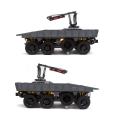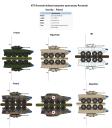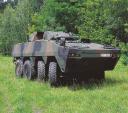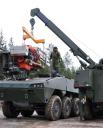Rosomak WZT
 Model of the Rosomak 8×8 APC. Features drive, steering, suspension with remotely adjustable ground clearance, 4-speed remote-controlled transmission, remotely opened rear door, motorized propellers, remote-controlled cargo crane, custom stickers and lights.
Model of the Rosomak 8×8 APC. Features drive, steering, suspension with remotely adjustable ground clearance, 4-speed remote-controlled transmission, remotely opened rear door, motorized propellers, remote-controlled cargo crane, custom stickers and lights.
Datasheet:
Completion date: 01/11/2015
Power: electric (Power Functions)
Dimensions: length 76 studs / width 30 studs / height 44 studs (including crane)
Weight: 4.022 kg
Suspension: full independent double wishbone suspension with remotely adjustable ground clearance
Propulsion: 8×8 with 2 x PF XL motor motor via a 4-speed sequential remote-controlled transmission with gear ratios from 1:11.6 to 1:2.33
Motors: 2 x PF XL motor, 8 x PF M motor
The Rosomak, or a Polish deep modification of the Finnish Patria 8×8 AMV manufactured in Poland under Finnish license, is a popular subject, especially among Polish builders. Having been deployed for years in Afghanistan and with nearly 1,000 units to be on active duty by 2019, these vehicles now effectively form the backbone of the Polish military and have become somewhat iconic, sort of like Humvees are icons of the US Army. Most importantly, they’re popular with soldiers, partially thanks to Rosomaks’ outstanding cross-country performance.
I have been looking for an opportunity to test my 4-speed remote-controlled sequential transmission for a while, and I was also thinking of building some 8×8 chassis. The Rosomak provided an opportunity for both, and once I actually got to visit the inside of a real Rosomak during 2015 Warsaw military parade, I felt I needed to build its model.
On the technical side, the model was, above all, slow. The reason was its massive weight exceeding 4 kg, which was unexpected, especially since a similar 6×6 vehicle I’ve built a few years ago, the BMR-2, was nearly just half as heavy. Still, at the 1st gear the model was well capable of slowly making its way across freshly dug up soil covered with fallen leaves, or driving across cobblestone with large holes, or climbing up a low ramp. It could still drive on a floor at 2nd and 3rd gear, while the 4th gear was only really useful for driving downhill. It was therefore sluggish and not overly impressive off-road, but I was happy with the fact that driving over all these obstacles with so much weight didn’t damage the chassis in any way, despite the presence of many fragile parts such as differentials and u-joints. The truth is, if I expected the finished model to be this heave, I would have probably used portal axles to protect the drivetrain parts from stress. I was particularly impressed by the transmission’s ability to handle all that stress without any problems – as shown in the video, it could actually shift while model was up on a ramp, and the driving rings managed to “catch” it as it started rolling down. It should be noted that there was no indicator of the currently selected gear whatsoever and I was shifting gears by ear, using two distinctive “clicks” as my cue.
The chassis featured 8×8 drive with two front axles steered with various steering lock. All wheels used double wishbone independent suspension which could be raised or lowered by moving the upper ends of the shock absorbers. The mechanism for raising/lowering suspension used a single PF M motor and it handled model’s weight surprisingly well, in part thanks to rotating liftarms that acted as locks, locking the mechanism in lowest and highest position so that the model’s weight rested on these liftarms rather than on the mechanism’s long axles. The “locks” were very effective and prevented the suspension from lowering spontaneously under load. The entire mechanism also changed hardness of the suspension by changing shock absorber’s angle: it was much harder when raised and much softer when lowered. I keep thinking that perhaps the opposite arrangement would make more practical sense, but in any case the difference in hardness is well visible in the video.
Other than drive, all functions, including steering, transmission control, suspension height and rear door (opened by a pair of small linear actuators) were powered by PF M motors. The same was true for all three functions of the cargo crane, which could be rotated, elevated and extended. Two of the crane’s motors were located inside the hull while the third one, controlling boom’s extension, was located in the crane itself. This solution proved to be poor, as stress on the crane’s turntable caused friction between one of the motors in the hull and the elevation mechanism in the crane. The crane itself was based on WZT, that is engineering variant of the Rosomak, because all Rosomak’s turrets seemed boring and too small for any interesting mechanisms to me. In reality, the Rosomaks use regular knuckleboom cranes of the type found on trucks, which look tiny and fragile on such a vehicle. At the same time the original Finnish Patria is only now getting a proper “combat” crane, which is much more massive and covered in the same camouflage as the vehicle’s hull, and this is where inspiration for my crane came from. Still, it was mostly made up.
One more PF M motor was used to drive two propellers at model’s back, and it was activated by a lever hidden between 3rd and 4th left wheel. The model was, of course, never intended for water and whatever buoyancy it could have had was rendered useless by its weight. Finally, there was a straight six piston engine in front, accessible via a hatch, which was connected to the propulsion motors directly. Thanks to that its speed was unaffected by transmission, just like in the real vehicle.
On the aesthetic side, I couldn’t help but feel that the model ended up crude. Part of the reason was the front end, where I’ve run into problems with making all the inclined surfaces meet without large gaps between them. This can be attributed to the well known issue of LEGO making just a few types of wedge plates which leaves only a handful of possible angles to use. I was also unhappy with the crane which just looked bad – but then so does the real one. Many details on the hull were made-up because for some reason documentation on the Rosomak is sparse in general, and almost non-existent for the WZT variant. I had to rely on a blueprint for a medivac variant (with a superstructure which I ignored) and I only found like 2 or 3 photos of the actual WXT version, each of them showing different details. In the end, I have used common reason to install details I knew for sure the real engineering variant would be using, such as towing cables and toolboxes, while omitting details I didn’t think I could get right, such as jerrycans (for some reason LEGO version of these always ends up looking like a bunch of basic bricks).
I was pretty sure the model wasn’t spectacular or innovative, it was just OK for me. It also felt somewhat too similar to the BMR-2 model which preceded it by 4 years. Still, it was satisfying to build something so large and heavy and see it take a lot of stress and handle plenty of obstacles without any damage. For all its weight, the model could successfully pass the so-called “wall test”, invented by LEGO Truck Trial builders, where a model has to drive into a wall and its motors should stall without damaging any part of the drivetrain. The Rosomak could do that and it has proven by transmission to be very practical – in fact, I don’t think any of my earlier transmission designs could have survived inside this model.
Work in progress photos:
Photos:
Video:
Media coverage:
Magazyn Allegro (Polish), The Lego Car Blog
















































O kurde chłopie!! To jest najlepszy model lego jaki kiedykolwiek widzialem!! Ciężko to będzie przebić!!! AVE SARIEL.
@Sariel
Thanks
W
@William
Usually from Google Images, by typing “name + blueprint”.
Hey Sariel,
I’m planing on making an “Challenger 2” Lego tank, and I was wondering where you get your blueprints from.
thanx, W
@Lauri Luttinen
Cheers! I know Finland as country of great metal bands and alcohol 😉
Hi Sariel,
Truly great job with Finnish Patria AMV, known as Rosomak in Poland. Nice model and nice Lego-design. Patria AMV is great success sroty also, I think a market leader in her class. Creetings from here north and I wish u succesfull Lego-Year 2016!
lauri
@Sergii
Did you try looking here? http://sariel.pl/downloads/
Hi! Your models are really nice!
Do you have any list of details to use to build them or any instructions?
Thanks!
@HP
Yes.
Did you use wheel hubs
@TechnoFan , @Foster , @Sariel
Come on guys, I know how bothering it is to have people tell you to submit your amazing creations to LEGO ideas. I’ve had this problem many times before, and after all three of my entries failed, I gave up. Really its not worth it. Make your own website, put your creations on there. LEGO Ideas VERY rarely accept even the best projects. Keep trying though, and I hope I haven’t destroyed your confidence, as it wasn’t the intention, just to put you back on earth. 🙂
@TechnoFan
Thank you, I’m not interested. I’m sure you can find a lot of help elsewhere.
Hi Sariel I might seem out of the way but the thing is I have some web pages which I need you to design for me since they are quite dull you could add some nice design to it and make it attractive just like yours. I am asking you this because you mentioned that you are a graphic designer in your F.A.Q and if this is our profession I could definitely expect some good work.
Sarcastic criticism welcome:-)
Thank You
@abc
Because the original turret is too small to fit a shooting mechanism inside.
The model is good why didn’t you make this with a shooting turrent.
@TechnoFan
No offence, but I think you need to get back to reality. Lego Ideas has rejected EVERY single Technic submission so far, EVERY single submission that was larger than 500 pieces, and recently they rejected ALL 15 submissions that passed the vote threshold. Here, watch this and stop believing in miracles: https://www.youtube.com/watch?v=yXekrsaJ8uU
Why don’t you submit this model to Lego ideas I am really sure this model will get selected I would love to see this model becoming a Lego set.And does raising the model reduce the speed. And could the six speed gear box be used in this model.
@Sariel
ok thanks!I just wanted to make a car with the philosophy of the land rover defender with three differentials(front,rear and central) but it didn’t work because of the central differential(it probably couldn’t control the high torque) so that’s why i was asking if you ever tried to do so…propably though you didn’t!anyway your vehicles seems very good even without a central differential!congrats for your amazing Mocs and thanks again!
@leobeni
No, the Rosomak doesn’t have a central differential, it just has one in each axle, 4 total.
hello sariel,i tried once to make a lego technic car with three differentials,but the central differential didn’t work properly,then trying to find why,i found that in the internet http://www.eurobricks.com/forum/index.php?showtopic=103016 (i mean the modified central differential) but i was not sure if it was the best idea..so what do you think about that?,also How many differentials does the rosomak have?does it have a central one?and if not,have you ever tried to use a central differential?
@Foster
I’m not going to support your project, sorry. I really, really don’t like the Lego Ideas program and I doubt any Technic entry has any chance to get approved. I wish your project all the best but this program has rejected every Technic entry so far. I don’t want to ruin your enthusiasm but they just rejected all 15 entries that qualified: https://www.youtube.com/watch?v=yXekrsaJ8uU
@Sariel I know this will seem a bit odd, and out of place. But could you support my Lego ideas project? It is a technic set, and I really want it to become a set. I think it has a possibility, it isn’t over the top but it is a possibility. It would be nice if you could somehow advertise it, but it doesn’t matter. All I’m asking for is for you to support it. You inspire me, and I would be honoured if you supported it
P.S. feel free to add some constructive critisism.
@Tobias Stanisfugl
Yes, it does have differentials. The wanky drive is typical for heavy Lego vehicles, it results from a complex drivetrain where a lot of backlash occurs. And the crane doesn’t reach the floor in the real vehicle either, because it doesn’t need to. The driving performance is poor exactly because it’s such a big model.
Hello Sariel, I think the model looks nice, but the driving performance is poor for such a big model, the gearbox becomes a joke. And the crane is a bit hilarious, since it not even reaches the floor…
I suppose the wanky nonfluent drive comes from too much elasticity in the drive train? Has it differentials? Am I wrong with the impression, that you sacrifice performance for more features in the last time?
Best Regards, Tobias Stanisfugl
@TechnoFan
I think it would get disqualified for not being a truck. And I didn’t use the SBrick because I could make it work with PF. SBrick would be making it too easy.
Outstanding!! This model is freaking good. Nice job keep it up.
Pros:Impressive size
Highly realistic
Cons:Suspension want work well when the model is raised.
Why you didnt use Sbrick for this model? And can this model be used for truck trial?